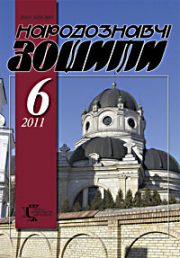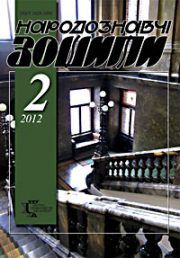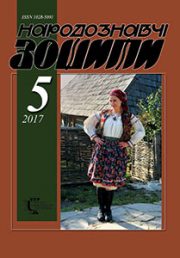The Ethnology Notebooks. 2017, 2 (134), 441—447
UDK 7.038.6
DOI https://doi.org/10.15407/nz2017.02.441
INNOVATIONS AND TECHNOLOGIES IN MODERN ART
Bystriakova Valentyna, Associate Professor
in Kiev National University of Technology and Design
Department of drawing and painting,
Volodymyra Nemyrovycha-Danchenko Street, 2, 01011, Kyiv, Ukraine.
Contacts: e-mail: krg@knutd.edu.ua
Osadcha Alla Mykolaivna, Senior teacher
in Kiev National University of Technology and Design
Department of drawing and painting,
Volodymyra Nemyrovycha-Danchenko Street, 2, 01011, Kyiv, Ukraine.
Contacts: E-mail: alla_0203@ukr.net
Pilhuk Olesia,
Kiev National University of Technology and Design
Department of drawing and painting,
Volodymyra Nemyrovycha-Danchenko Street, 2, 01011, Kyiv, Ukraine.
Contacts: e-mail: krg@knutd.edu.ua
Abstract. In the article the attempt of analysis of the systems of innovative approaches and innovative technologies in a modern art is carried out. The different scientific and legal going is offered near interpretation of term «innovation». Understanding of essence of innovations in a culture is investigated. The features of application of innovative technologies are considered in the different spheres of culture, in particular in fine art. The role of innovative technologies is exposed in the postmodern art.
Keywords: innovations, technologies, modern art, culture, cultureronik, values, tradition, postmodern, conception.
Received 14.03.2017
REFERENCES
Balabanov, I.T. (2001). Innovacionyj menedzhment. Sankt-Peterburg: Piter [in Russian].
Volyk, N.H. (2013). Innovatsijni suspil’ni protsesy i moral’nyj vybir. Totallogy XXI. Postneklasichni doslidzhennia, 30, 265—273 [in Ukrainian].
Vujma, A.H. (2013). Tradytsii ta novatorstvo iak dvi protylezhnosti v dialektytsi kul’tury. In Problema tradytsii v ukrains’kij kul’turi: materialy Vse-ukrains’koi naukovopraktychnoikh konferentsii kursantiv, studentiv ta molodykh uchenykh (pp.36—38). Kharkiv: NUTsZU [in Ukrainian].
Gvishiani, D.M. (2006). Dialektika i sistemnyj analiz. Moskva: Nauka [in Russian].
Druker, P.F. (2007). Zadachi menedzhmenta v XXI veke. Moskva: Vil’jams [in Russian].
Zhaldak, H. & Simchenko, N. (2012). Klasyfikatsiia innovatsij ta ikh sotsial’nyj pidvyd. In Ekonomichnyj analiz (Vol. 10 (4), pp. 92—95) [in Ukrainian].
Kyrylenko, K.M. (2015). Pidkhody do rozuminnia innovatsijnoi kul’tury v konteksti su-chasnoho naukovoho dyskursu ta ikh naskrizni idei. Pytannia kul’turolohii, 31, 64—71 [in Ukrainian].
Koiuda, O.P. & Nebylytsia, O.A. (2009). Innovatsijna kul’tura ta ii kharakterni osoblyvosti. Problemy nauky, 7, 15—20 [in Ukrainian].
Konvers’kyj, A.Ye. (Ed.). (2013). Kul’turolohiia: pidruch. dlia studentiv vysch. navch. zakl. Kharkiv: Folio [in Ukrainian].
Liotar, Zh.F. & Shmako N.A. (per. s fr.). (1998). Sostojanie postmoderna = La condition postmoderne. Sankt-Peterburg: Aletejja [in Russian].
Miliutina, Yu.S. (2011). Dyskusijni pytannia schodo vyznachennia poniat’ «innovatsiia» ta «novovvedennia». Universytets’ki naukovi zapysky, 4, 454—462 [in Ukrainian].
Molchanova, L.A. (2011). Innovacii v zhivopisi vtoroj poloviny XX veka. Mir nauki, kul’tury, obrazovanija, 6 (31), 201—202 [in Russian].
Molchanova, L.A. (2010). Ponjatija «innovacija» i «tradicija» v iskusstve. In Snitkovskie chtenija. (pp. 37—43). Barnaul: Altajskij dom pechati [in Russian].
Sydorenko, V. (Ed.). (2006). Narysy z istorii obrazotvorchoho mystetstva Ukrainy XX st. (Vol. 2). Kyiv: Intertekhnolohiia [in Ukrainian].
Nepomnjashhij, A.V. & Pisarenko B.I. (2007). Innovacionnoe obrazovanie: dostizhenija i perspektivy. Vysshee obrazovanie segodnja, 7, 14—19 [in Russian].
Nesterenko, O.S. (2013). Klasyfikatsiia vydiv innovatsij ta efektiv vid ikh vprovadzhennia. Visnyk sotsial’noekonomichnykh doslidzhen’, 4, 112—117 [in Ukrainian].
Gricanov, A.A. (Ed.). (2007). Novejshij filosofskij slovar’. Postmodernizm. Minsk: Sovremennyj literator [in Russian].
Pro innovatsijnu diial’nist’: Zakon Ukrainy: zi zminamy. (2003). In Vidomosti Verkhovnoi Rady Ukrainy (VVR),13, 93 [in Ukrainian].
Sobol’, T.V. (2014). Filosofskij analiz soderzhanija ponjatij «kul’tura», «innovacija» i «innovacionnaja kul’tura». Molodoj uchenyj, 13, 337—341 [in Russian].
Starovojt, O.V. (2014). Kreatyvna pryroda innovatsijnoi kul’tury. Visnyk Instytutu rozvytku dytyny. Seriia: Filosofiia, pedahohika, psykholohiia, 32, 36—42 [in Ukrainian].
SukhovejKhamm, Yu.O. (2012). Teoretychni pidkhody do traktuvannia poniattia innovatsij u suchasnij naukovij literature. Naukovi pratsi MAUP 4, 180—184 [in Ukrainian].
Usovskaja, Je.A. (2006). Postmodernizm. Minsk: TetraSistem [in Russian].
Ushkalov, L. (2011). Vid baroko do postmodernu: esei. Kyiv: Hrani T [in Ukrainian].
Shumpeter, J. (2007). Teorija jekonomicheskogo razvitija. Moskva: Jeksmo [in Russian].
Jepshtejn, M.N. (2004). Znak probela: O budushhem gumanitarnyh nauk. Moskva: Novoe literaturnoe obozrenie [in Russian].






